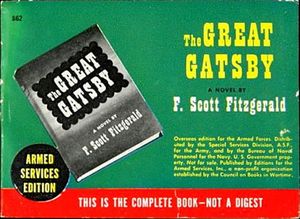Second acts: How World War II kick-started American literature

From Dr. Baker: Today, Terry Gallagher concludes his series on “Second Acts in American Lives” …
Well, look who’s back on top of the best-seller list! Boosted by the release of the 3-D film version starring Leonardo DiCaprio, F. Scott Fitzgerald’s classic novel The Great Gatsby hit No. 1 on Amazon’s best sellers list for a week in May.
It's hard to believe now, but the book wasn’t a best seller when it was published in 1925. As Fitzgerald’s editor at Scribner’s, the legendary Max Perkins, wired him: SALES SITUATION DOUBTFUL EXCELLENT REVIEWS.
It didn’t get much better. In 1929, Fitzgerald’s records showed royalties of $5.10 from the American edition of The Great Gatsby and $0.34 from the English edition. In 1940, the royalties were a very unlucky $13.13.
So what happened to make the book one of the most popular and enduring in all of American literature?
In large part, it was because of World War II. During the war, American publishers worked with the military to provide books to soldiers as a way to boost morale. The Great Gatsby was one of the 1,322 titles included in this global distribution campaign. As a result, 155,000 copies of Gatsby were distributed between 1942 and 1946, far surpassing the 25,000 copies Scribner’s printed from 1925 to 1942, thousands of which were never sold.
How successful was the program overall? The books were “as popular as pin-up girls,” one soldier told the Saturday Evening Post.
Many scholars believe that was the impetus that made the book a popular success.
Nowadays, Scribner’s sells about half-million copies every year, both in print and e-books, and the rights generate about $500,000 per year for Fitzgerald’s heirs.
How’s that for a second act?

